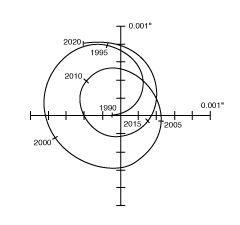Mesoamerican Long Count calendar
Main article: Mesoamerican Long Count calendar
December 2012 marks the conclusion of a b'ak'tun—a time period in the Mesoamerican Long Count calendar which was used in Central America prior to the arrival of Europeans. Although the Long Count was most likely invented by the Olmec,[10] it has become closely associated with the Maya civilization, whose classic period lasted from 250 to 900 AD.[11] The writing system of the classic Maya has been substantially deciphered,[12] meaning that a corpus of their written and inscribed material has survived from before the European conquest.
Unlike the 52-year Calendar Round still used today among the Maya, the Long Count was linear rather than cyclical, and kept time roughly in units of 20: 20 days made a uinal, 18 uinals (360 days) made a tun, 20 tuns made a k'atun, and 20 k'atuns (144,000 days or roughly 394 years) made up a b'ak'tun. Thus, the Mayan date of 8.3.2.10.15 represents 8 b'ak'tuns, 3 k'atuns, 2 tuns, 10 uinals and 15 days.[13][14]
Apocalypse
There is a strong tradition of "world ages" in Mayan literature, but the record has been distorted, leaving several possibilities open to interpretation.[15] According to the Popol Vuh, a compilation of the creation accounts of the K'iche' Maya of the Colonial-era highlands, we are living in the fourth world.[16] The Popol Vuh describes the gods first creating three failed worlds, followed by a successful fourth world in which humanity was placed. In the Maya Long Count, the previous world ended after 13 b'ak'tuns, or roughly 5,125 years.[17][Note a] The Long Count's "zero date"[Note b] was set at a point in the past marking the end of the third world and the beginning of the current one, which corresponds to 11 August 3114 BC in the proleptic Gregorian calendar.[18][Note c] This means that the fourth world will also have reached the end of its 13th b'ak'tun, or Mayan date 13.0.0.0.0, on 21 December 2012.[1][Note c] In 1957, Mayanist and astronomer Maud Worcester Makemson wrote that "the completion of a Great Period of 13 b'ak'tuns would have been of the utmost significance to the Maya".[19] In 1966, Michael D. Coe wrote in The Maya that "there is a suggestion ... that Armageddon would overtake the degenerate peoples of the world and all creation on the final day of the 13th [b'ak'tun]. Thus ... our present universe [would] be annihilated [in December 2012][Note d] when the Great Cycle of the Long Count reaches completion."[20]


